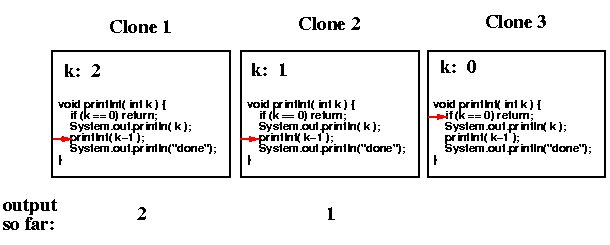
void f()
{ ... f() ... }
or indirectly:
void f()
{ ... g() ... }
void g()
{ ... f() ... }
You might wonder about the following issues:
Q: Does using recursion usually use less memory?
A: No.
Q: Then why use recursion?
A: It sometimes makes your code much simpler!
void printInt( int k ) {
1. if (k == 0) return;
2. System.out.println( k );
3. printInt( k - 1 );
4. System.out.println("all done");
}
If the call printInt(2) is made, three "clones" are created, as illustrated
below:

The original call causes 2 to be output, and then a recursive call is made, creating a clone with k == 1. That clone executes line 1 (the if condition is false), line 2 (prints 1), and line 3: makes another recursive call, creating a clone with k == 0. That clone just returns (goes away). The previous clone executes line 4 (the line after its saved position) then returns, and similarly for the original clone.
Now let's think about what we have to do to make sure that recursive methods work correctly. First, consider the following recursive method:
void badPrint( int k ) {
System.out.println( k );
badPrint( k + 1 );
}
Note that a runtime error will occur when the call badPrint(2) is made
(in particular, an error message like "java.lang.StackOverflowError" will
be printed, and the program will stop). This is because there is no code
that prevents the recursive call from being made again and again and ....
and eventually the program runs out of memory (to store all the clones).
This is an example of an infinite recursion. It inspires:
*** RECURSION RULE #1 ***
void badPrint2( int k ) {
if (k < 0) return;
System.out.println(k);
badPrint2( k+1 );
}
This inspires:
Consider the method printInt, repeated below.
void printInt( int k ) {
if (k == 0) return;
System.out.println( k );
printInt( k - 1 );
}
Does it obey recursion rules 1 and 2? Are there calls that will lead to
an infinite recursion? If yes, how could it be fixed?
1. void printChar( char c ) {
2. System.out.println(c);
3. }
4.
5. void main (...) {
6. char ch = 'a';
7. printChar(ch);
8. ch = 'b';
9. printChar(ch);
10. }
The runtime stack of activation records is shown below, first as it would
be just before the first call to printChar (just after line 6), and then
as it would be while printChar is executing (lines 1 - 3). Note that the
return address stored in printChar's AR is the place in main's code where
execution will resume when printChar returns.
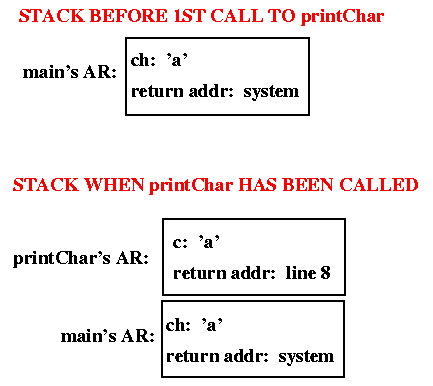
When the first call to printChar returns, the top activation record is popped from the stack and the main method begins executing again at line 8. After executing the assignment at line 8, a second call to printChar is made (line 9), as illustrated below.
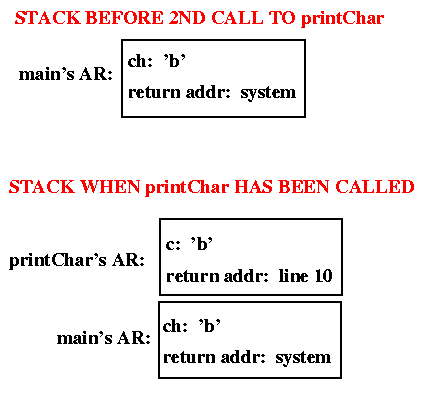
The two calls to printChar return to different places in main because different return addresses are stored in the ARs that are pushed onto the stack when the calls are made.
Now let's consider recursive calls:
1. void printInt( int k ) {
2. if (k <= 0) return;
3. System.out.println( k );
4. printInt( k - 1 );
5. }
6.
7. void main(...) {
8. printInt(2);
9.}
The following pictures illustrate the runtime stack as this program executes.
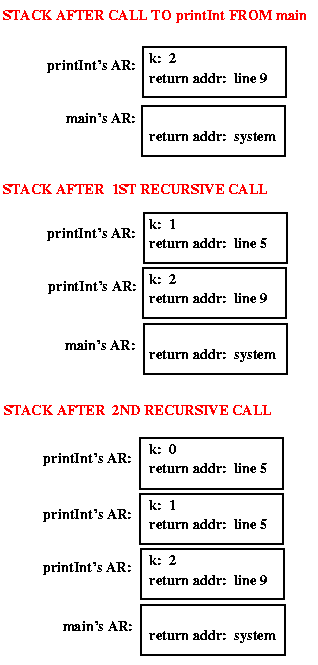
Note that all of the recursive calls have the same return address -- after a recursive call returns, the previous call to printInt starts executing again at line 5. In this case, there is nothing more to do at that point, so the method would, in turn, return.
Note also that each call to printInt causes the current value of k to be printed, so the output of the program is: 2 1 (where each value is on its own line).
Now consider a slightly different version of the printInt method:
1. void printInt (int k) {
2. if (k<=0) return;
3. printInt (k-1);
4. System.out.println(k)
5. }
Now what is printed as a result of the call printInt(2)? Because the print
statement comes after the recursive call, it is not executed until
the recursive call finishes (i.e., printInt's activation record will have
line 4 -- the print statement -- as its return address, so that line will
be executed only after the recursive call finishes). In this case, that
means that the output is: 1 2 (instead of 2 1, as it was when the print
statement came before the recursive call). This leads to the following
insight:
*** UNDERSTANDING RECURSION ***
void printTwoInts( int k ) {
if (k == 0) return;
System.out.println( "From before recursion: " + k );
printTwoInts( k - 1 );
System.out.println( "From after recursion: " + k );
}
What is printed as a result of the call printTwoInts(3)?
Q: Does the recursive version usually use less memory?
A: No -- it usually uses more memory (for the stack).
Q: Then why use recursion??
A: Sometimes it is much simpler to write the recursive version (but
we'll need to wait until we've discussed trees to see really good
examples...)
The first definition leads to an iterative version of factorial:
int factorial (int N) {
if (N == 0) return 1;
int tmp = 1;
for (int k=N; k>1; k--) tmp = tmp*k;
return (tmp);
}
The second definition leads to a recursive version:
int factorial (int N) {
if (N == 0) return 1;
else return (N*factorial(N-1));
}
The recursive version is
Question 1:
Draw the runtime stack, showing the activation records that would be
pushed as a result of the call factorial(3) (using the recursive version
of factorial). Just show the value of N in each AR (don't worry about the
return address). Also indicate the value that is returned as the
result of each call.
Question 2:
Recall that (mathematically) factorial is undefined for a negative
number. What happens as a result of the call factorial(-1) for each of
the two versions (iterative and recursive)? What do you think really should
happen when the call factorial(-1) is made? How could you write the method
to make that happen?
int fib (int N) {
int k1, k2, k3;
k1 = k2 = k3 = 1;
for (int j = 3; j <= N; j++) {
k3 = k1 + k2;
k1 = k2;
k2 = k3;
}
return k3;
}
int fib (int N) {
if ((N == 1) || (N == 2)) return 1;
else return (fib (N-1) + fib (N-2));
}
For fibonacci, the recursive version is:
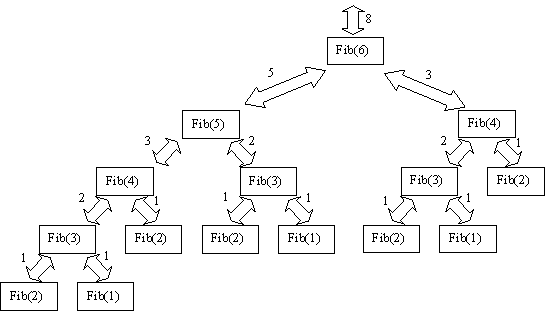
Note: one reason the recursive version is so slow is that it is repeating
computations. For example, fib(4) is computed twice, and fib(3) is computed
3 times.
Given that the recursive version of fibonacci is slower than the iterative version, is there a good reason for using it? The answer may be yes: because the recursive solution is so much simpler, it is likely to take much less time to write, debug, and maintain. If those costs (the cost for programming time) are more important than the cost of having a slow program, then the advantages of using the recursive solution outweigh the disadvantage, and you should use it! If the speed of the final code is of vital importance, then you should not use the recursive fibonacci.
When using induction to prove a theorem, you need to show:
Now we need to show that if factorial(k) = k!, then factorial(k+1) = (k+1)!. Looking at the code we see that for N != 0, factorial(N) = (N)*factorial(N-1). So factorial(k+1) = (k+1)*factorial(k). By assumption, factorial(k) = k!, so factorial(k+1) = (k+1)*(k!). By definition, k! = k*(k-1)*(k-2)*...*3*2*1. So (k+1)*(k!) = (k+1)*k*(k-1)*(k-2)*...*3*2*1, which is (by definition) (k+1)!, and the proof is done.
Note that we've shown that the factorial method is correct for all values of N greater than or equal to zero (because our base case was N=0). We haven't shown anything about factorial for negative numbers. This is also true for the mathematical induction proof which starts with N = 0.